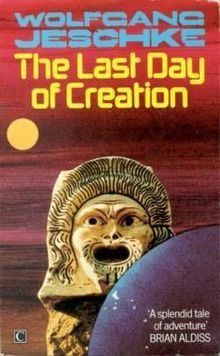Country Germany Publication date 1981 Originally published 1981 Genre Science Fiction OCLC 10300910 | Published in English 1982 Published in english 1982 | |
 | ||
Original title 'Der letzte Tag der Schöpfung' Media type Print (Hardback & Paperback) Science Fiction books Replay, Timescape, Dying Inside, Gateway, The Mote in God's Eye | ||
The Last Day of Creation (in original German: Der letzte Tag der Schöpfung) is a science fiction novel by German writer Wolfgang Jeschke, first published in 1981. The English translation was published in 1982 in the USA and Great Britain. In the same year the novel obtained the Kurd-Laßwitz-Preis (Kurd Laßwitz award).
Contents
The computer game Original War (2001) is freely based on the novel.
Plot
The book is structured into three parts.
The first part describes several ancient artifacts that turn out to be remnants of modern era items: a part of a pilot's breathing apparatus worshipped for centuries as a Catholic saintly relic, a clearly recognizable trace of a Jeep discovered during archaeological works on Gibraltar, found in the same layer as an early hominid skeleton, and an equally old grenade launcher of a model just introduced in the US Army. William W. Francis, an ambitious officer of the US Navy, becomes convinced that time travel is possible and manages to launch a secret project to develop a technological device able to transfer people and materiel through time.
The second part describes the project "Chronotron", the successful implementation of a time machine, which is at first able only to move things into the past. It is believed that time transfer into the future will be solved soon. The American administration decides to move oil pumping machinery 5 million years into the past, set it up on oil deposits in the Near East, and transport the oil through the then dried-up Mediterranean Basin to the shores of the North Sea, where reverse time machines will push it to the modern era. The massively expensive project is kept strictly secret. Objections of scientists that time transfer into the future may be just a dream, that the project could exhaust the country in a new arm race, and that the history of humankind may be irreversibly changed, are ignored.
The third part introduces Steve Stanley, a military pilot picked up to participate in the project. His task is to protect the installations and specialists transferred into the past. Stanley successfully descends into the prehistoric Mediterranean. He is surprised to arrive in the middle of an all-out war, where newcomers are chased by nuclear artillery. He learns that the plan went completely wrong: isolated groups of Americans were scattered through time more widely than calculated, the reverse time transfer is impossible, and worst of all, Arabs had discovered the plan and decided to strike back by sending their own soldiers into the same period to destroy the American expedition. Stanley meets people who arrived from various different futures, including one where the United States is limited to the east of the Mississippi and Mexico is the superpower. Most of the time travellers, unable to adjust to life without modern amenities and having no practical skills, have been evacuated to a base on the Bermudas, and the rest try to fend off attackers and to rescue unsuspecting newcomers. Overall, the situation seems hopeless and the handful of modern humans have no chance to set up a new civilization.
